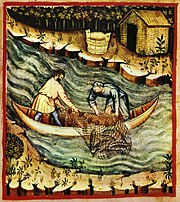|
Marlin Fishing Miami
Marlin, Istiophoridae, is a member of a larger grouping of marine fishes known as "billfish", of which several are popular in big-game fishing. They have an elongated body that in the larger species can exceed 4 m (13 ft) in length, a spear-like snout, and a long rigid dorsal fin, which extends forwards to form a crest. The common name is thought to derive from its notional resemblance to a sailor's marlinspike.[1] Marlin are known to be incredibly fast swimmers, reaching speeds in of about 80 km/h (50 mph).[2]
The larger species include the Atlantic blue marlin, Makaira nigricans, which have been reliably recorded in excess of 2 m (7 ft) in length and 120 kg (250 lb) in weight (gross underestimate; see www.roanoke.com/outdoors/billcochran/field/wb/173789), and the Black marlin, Makaira indica, which have been reliably recorded in excess of 5 m (16 ft) in length and 670 kg (1,470 lb) in weight. They are popular sporting fish in certain tropical areas.
Marlin are rarely table fare, appearing mostly in fine dining restaurants. Most modern sport fishermen release marlin after unhooking. However, the old fisherman in Ernest Hemingway's novella The Old Man and the Sea was storied to have caught an 18-foot marlin in order to sell its meat at market.
Some marlin that are top record setting fish are taken and weighed on shore. Those records are most often recorded in the IGFA World Record Game Fish books.
There are numerous references to fishing in ancient literature; in most cases, however, the descriptions of nets and fishing-gear do not go into detail, and the equipment is described in general terms. An early example from the Bible in Job 41:7: Canst thou fill his skin with barbed irons? Or his head with fish spears?.


Fishing with nets, tacuinum sanitatis casanatensis (XIV century)
Fishing scenes are rarely represented in ancient Greek culture, a reflection of the low social status of fishing. There is a wine cup, dating from c. 500 BC, that shows a boy crouched on a rock with a fishing-rod in his right hand and a basket in his left. In the water below, a rounded object of the same material with an opening on the top. This has been identified as a fish-cage used for keeping live fish, or as a fish-trap. It is clearly not a net. This object is currently in the Museum of Fine Arts, Boston.[9]
Oppian of Corycus, a Greek author wrote a major treatise on sea fishing, the Halieulica or Halieutika, composed between 177 and 180. This is the earliest such work to have survived intact to the modern day. Oppian describes various means of fishing including the use of nets cast from boats, scoop nets held open by a hoop, spears and tridents, and various traps "which work while their masters sleep". Oppian's description of fishing with a "motionless" net is also very interesting:
The fishers set up very light nets of buoyant flax and wheel in a circle round about while they violently strike the surface of the sea with their oars and make a din with sweeping blow of poles. At the flashing of the swift oars and the noise the fish bound in terror and rush into the bosom of the net which stands at rest, thinking it to be a shelter: foolish fishes which, frightened by a noise, enter the gates of doom. Then the fishers on either side hasten with the ropes to draw the net ashore.
The Greek historian Polybius (ca 203 BC–120 BC), in his Histories, describes hunting for swordfish by using a harpoon with a barbed and detachable head.[10]
Pictorial evidence of Roman fishing comes from mosaics which show fishing from boats with rod and line as well as nets. Various species such as conger, lobster, sea urchin, octopus and cuttlefish are illustrated.[11] In a parody of fishing, a type of gladiator called retiarius was armed with a trident and a casting-net. He would fight against the murmillo, who carried a short sword and a helmet with the image of a fish on the front.
The Greco-Roman sea god Neptune is depicted as wielding a fishing trident.


Dutch fishermen using tridents in the 17th century
In India, the Pandyas, a classical Dravidian Tamil kingdom, were known for the pearl fishery as early as the 1st century BC. Their seaport Tuticorin was known for deep sea pearl fishing. The paravas, a Tamil caste centred in Tuticorin, developed a rich community because of their pearl trade, navigation knowledge and fisheries.
In Norse mythology the sea giantess Rán uses a fishing net to trap lost sailors.
The Moche people of ancient Peru depicted fisherman in their ceramics. [12]
From ancient representations and literature it is clear that fishing boats were typically small, lacking a mast or sail, and were only used close to the shore.
In traditional Chinese history, history begins with three semi-mystical and legendary individuals who taught the Chinese the arts of civilization around 2800?2600 BC: of these Fu Hsi was reputed to be the inventor of writing, hunting, trapping, and fishing.
South Florida and Miami fishing available at an affordable price. |











